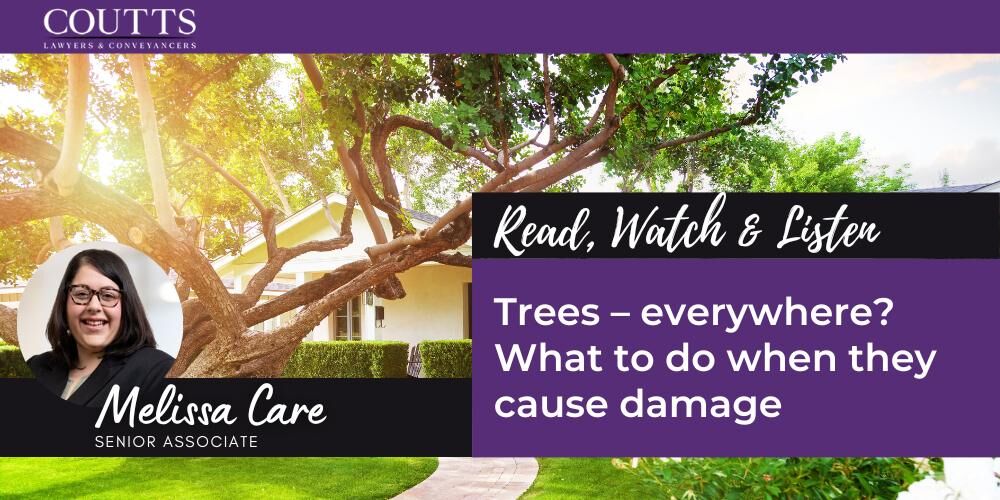KEY TAKE-OUTS:
- Before you take steps to remove or trim a tree consider the Trees (Dispute Between Neighbours) Act 2006.
- To help you understand the Trees Act, we have answered your most common questions including, where does the Trees Act apply? When is a tree a ‘tree’? What is the process to make an application under the Trees Act?
- Typically, claims under the Trees Act pertains to property damage or personal injury and such claims may include claims for compensation.
Everybody has fond memories of beautiful trees in their local playground, neighbourhood or own yard. You may enjoy watching your kids climb beautiful old trees while you are out and about. Trees bring a joyful amenity to their location. But, sometimes those trees in your backyard or your neighbours’ backyard are more trouble than treasure.
Have you ever thought any of the following:
- “That tree needs to come down – those roots are ruining my driveway”;
- “This tree needs to come down, these falling branches are going to hurt someone”;
- “That neighbour’s tree is caving in our fence, we need to cut it down ourselves before it causes any more damage”.
Before you take any steps to rectify a troublesome tree, you should consider the Environmental Planning and Assessment Act 1979 and the Trees (Dispute Between Neighbours) Act 2006 (the Trees Act), and it may be useful to discuss the issues with a qualified arborist.
To help your understanding of the Trees Act, we have set out some common questions and answers in this article.
When is a Tree a Tree?
Under the Trees Act, a tree is defined as being:
“Any woody perennial plant, any plant resembling a tree in form and size, and any other plant prescribed by the regulations”
Case law has expanded this definition to include shrubs.
The Trees (Disputes Between Neighbours) Regulation 2007 provides further expansion of the definition to include bamboo and vines, as well as hedges made up of group plantings of trees.
Importantly, the ‘tree’ must be located entirely or predominantly on the land adjoining the applicant’s property.
Where does the Trees Act apply?
The Trees Act applies to any privately owned land which is located in a residential, village, township, industrial or business zone.
Rural residential land and Crown land (excluding schools) are exempt.
If you are not sure of the zoning of the affected property, the Environment and Planning team at Coutts can assist you in locating this information.
Are Council Owned Trees Included?
Trees located on council owned land are exempt from the Trees Act.
If a Council owned tree is causing issues on your property, this should be taken up directly with the relevant local council.
If you need assistance liaising with Council, the team at Coutts can provide guidance as necessary.
Why would you make an application under the Tress Act?
The best way to resolve any dispute is to try to resolve it directly with the owner of the property on which the problem tree is located.
However, if this proves to be impossible, you can apply to the Land and Environment Court for an order to remedy, restrain or prevent further damage being caused by the tree.
In addition, you may also apply for compensation for any damage already caused by the tree, such as damage to property or to business trade.
The Environment and Planning Team at Coutts can assist you in any dispute regarding trees including making the relevant application in the Land and Environment Court.
Who can make an application?
The owner or occupier of a property which adjoins the property where the problem tree is located can make an application to the Land and Environment Court under the Trees Act. This also includes Tenants.
How do you make an application under the Trees Act?
An application can be made directly to the Land and Environment Court.
These applications are dealt with by Commissioners as Class 2 proceedings.
Coutts’ Environment and Planning team can assist you with making this application and representing you in the proceedings.
What does the Land and Environment Court take into consideration?
Typically, a claim under the Trees Act pertains to property damage or personal injury, such claims may include claims for compensation. In these proceedings, the Land and Environment Court requires the applicant to provide satisfactory evidence that:
- In accordance with section 10(1) of the Trees Act, all reasonable efforts have been undertaken to try and resolve the dispute directly with the owner of the property that the disputed tree is located on
- The subject tree has, is or will cause damage to the applicant’s property
- In relation to personal injury claims, that the subject tree has or is more than likely to cause injury to a person
The Land and Environment Court must be satisfied in relation to the matters listed above and to other matters set out in the Trees Act, to issue an order, otherwise no order will be issued.
Where the application concerns hedges obscuring sunlight, the court will also consider whether the trees forming the hedge were planted or self sown and whether they are greater than 2.5 metres in height.
If you intend to commence action against a neighbour under the Trees Act reach out to Coutts and we can guide you through the process and advise as to whether your claim satisfies the considerations that must be met under the Trees Act.
ABOUT MELISSA CARE:
Melissa is a Senior Associate at Coutts Lawyers & Conveyancers working from our Campbelltown Office and has extensive experience in the areas of Civil Disputes & Litigation, Building and Construction Disputes, Commercial Litigation & Employment Law for both corporate clients and individuals.
Melissa holds a Bachelor of Laws, Bachelor of Commerce (Majoring in Marketing), Graduate Law Diploma from the College of Law; and has been admitted to the Supreme Court of NSW and the High Court of Australia.
For further information please don’t hesitate to contact:
Melissa Care
Senior Associate
info@couttslegal.com.au
1300 268 887
This blog is merely general and non-specific information on the subject matter and is not and should not be considered or relied on as legal advice. Coutts is not responsible for any cost, expense, loss or liability whatsoever to this blog, including all or any reliance on this blog or use or application of this blog by you.




